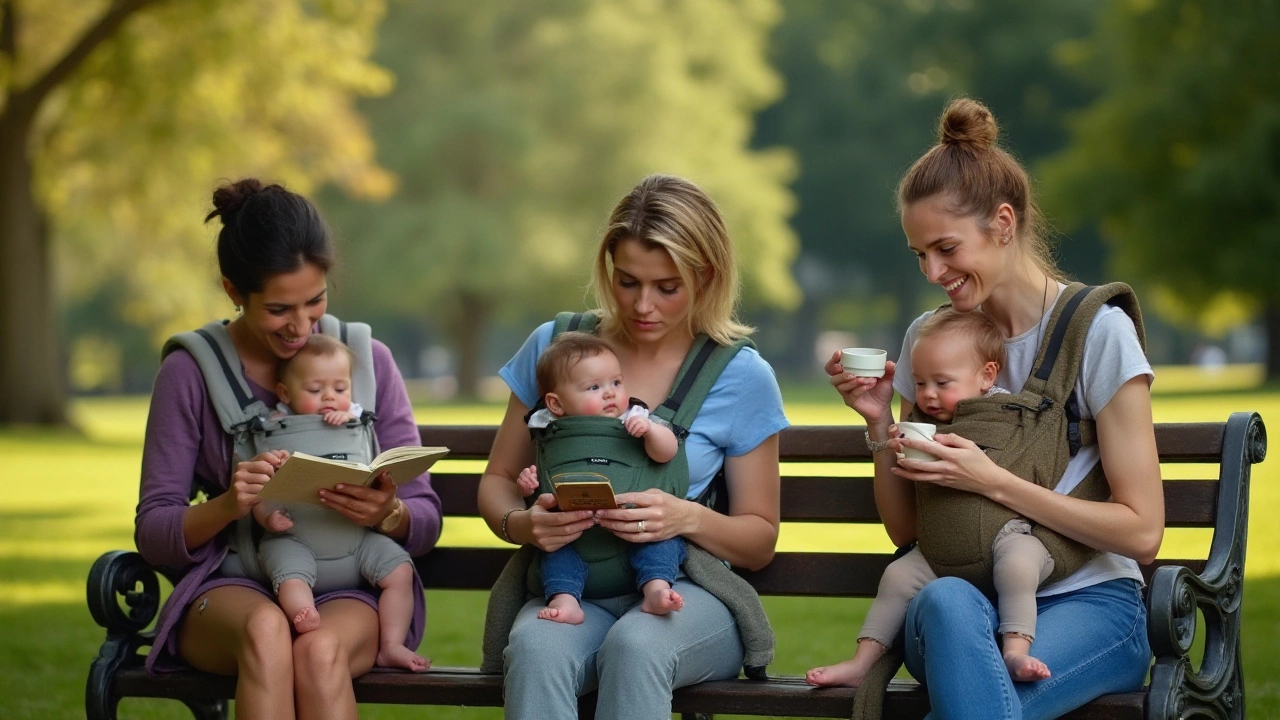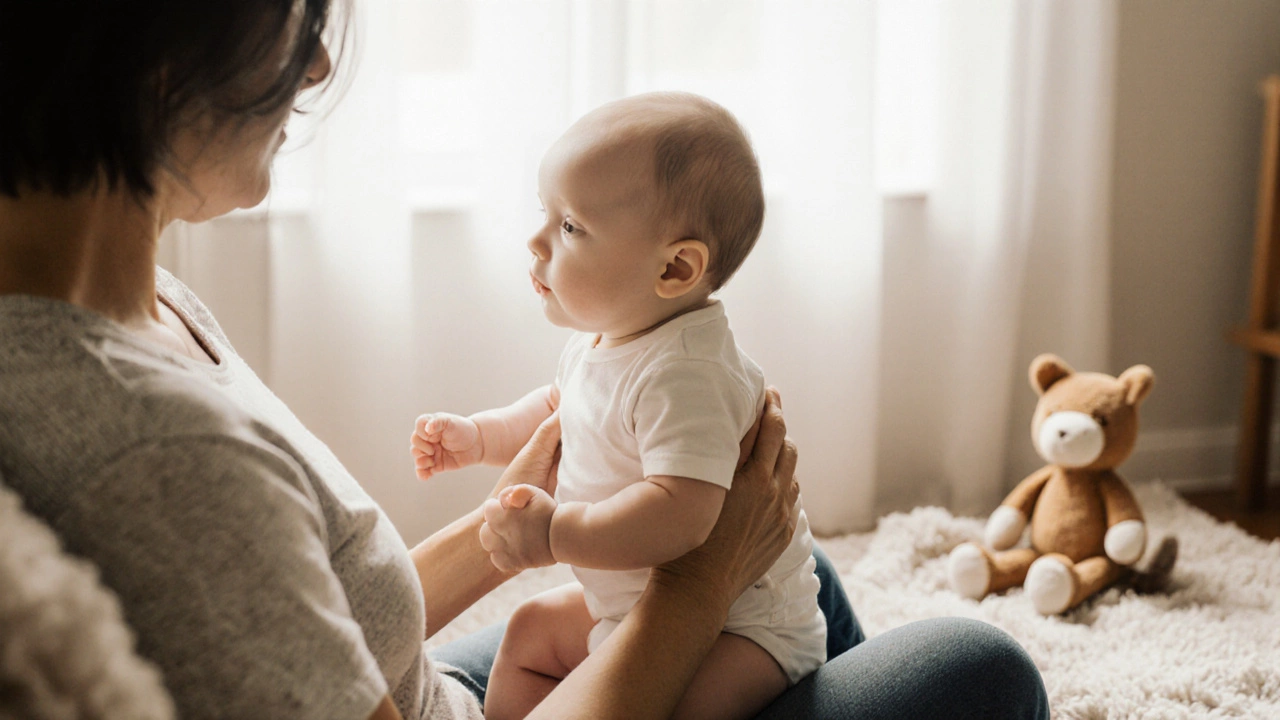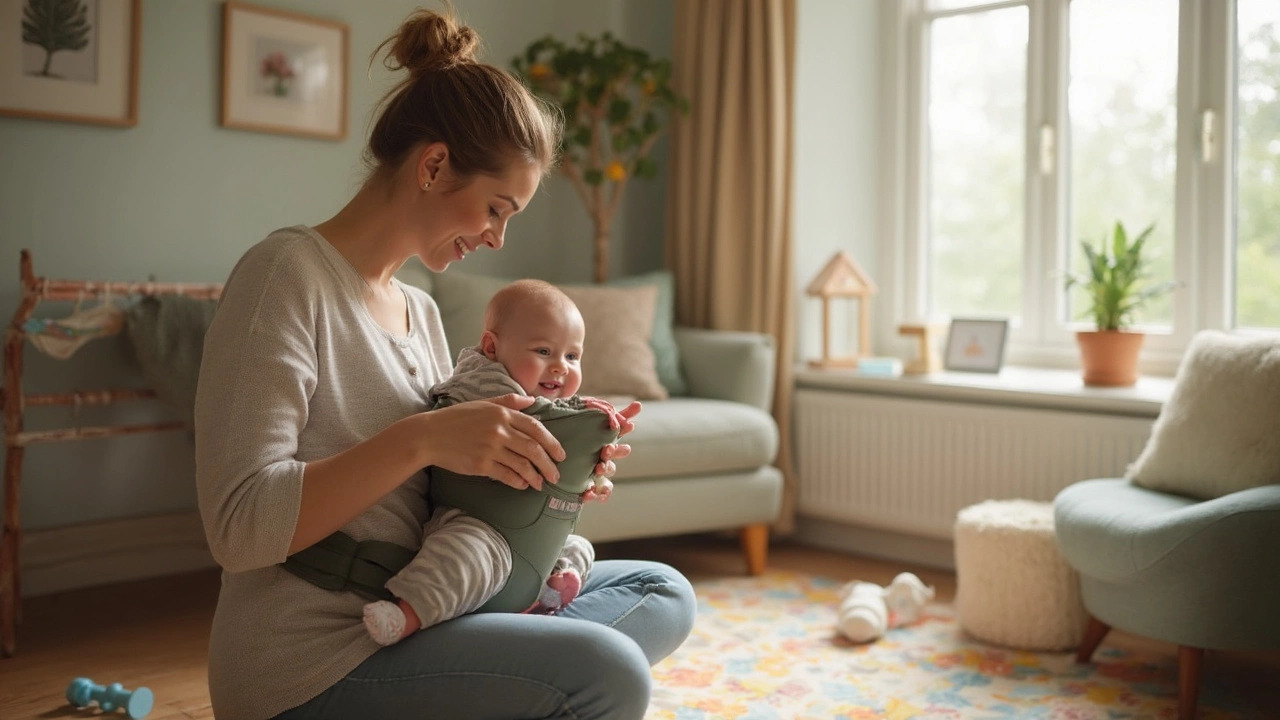How Long Can You Safely Keep a Baby in a Carrier?

Baby carriers have become a staple in modern parenting, offering a blend of convenience and closeness. They allow you to navigate daily life while keeping your little one close and secure. However, like all good things, there's a balance to be struck, especially regarding how long your baby can stay in a carrier.
Ensuring your baby’s safety and comfort is paramount, so understanding the recommended time limits can make all the difference. This guide seeks to shed light on how to use baby carriers effectively, focusing on the delicate dance between supervision, comfort, and practicality.
- Understanding Baby Carrier Benefits
- Optimal Duration for Babywearing
- Safety and Comfort Considerations
- Reading Infant Cues
- Choosing the Right Carrier
Understanding Baby Carrier Benefits
Baby carriers have revolutionized infant care, blending modern design with ancient practices to provide a marvelous solution for busy parents. It goes beyond merely freeing your hands; carriers offer both emotional and physiological advantages. By keeping your infant snug against your body, you are promoting feelings of security, not unlike the familiar closeness of the womb. This proximity is not just soothing; it is essential for newborns developing their understanding of the world around them. Studies have revealed that babies who are carried often cry less—a benefit that every parent can appreciate.
Being in a carrier allows infants to hear your heartbeat, feel your warmth, and learn from facial expressions and interactions right at eye level, fostering cognitive development. Dr. William Sears, a renowned pediatrician, has emphasized the 'attachment parenting' aspect of babywearing, stating that it helps align parents and children emotionally, leading to more intuitive parenting.
"Babywearing helps parents become attuned to their baby's cues and needs," he often noted.The physical closeness also plays a significant role in regulating a baby’s temperature and helps in better digestion due to the upright position. Additionally, movement benefits a child's developing nervous system and promotes balance and coordination during the early stages of life.
It’s essential to understand that babywearing is not just beneficial for the infant; it aids the parent as well. From a practical standpoint, a carrier allows you to navigate tight spaces and manage tasks with ease, whether you're shopping, running errands, or simply moving around the house. Carrying your baby in a proper carrier can also mitigate physical strain by distributing weight evenly across your shoulders and hips, reducing back and neck pain. This ergonomic advantage often makes it significantly easier than carrying a child in your arms.
For those who love exploring the great outdoors, many modern carriers are designed with adventure in mind, offering features like sunshades, rain covers, and storage pockets. Babywearing gives parents the flexibility to maintain an active lifestyle, and infants get to experience the world from a secure perch. The structural design of carriers has evolved, with an emphasis on safety; top manufacturers routinely score high marks in safety ratings, providing peace of mind alongside convenience. Encountering new environments together helps babies adapt more easily to changes, which can lay a foundation for an open mindset as they grow older.
A particularly interesting point to note is how baby carriers vary globally, reflecting cultural differences and innovations. In parts of Africa, for example, the traditional kanga is a staple; in Japan, it's a closely stitched wrap known as the 'Onbuhimo'. These diverse styles show how integral and advantageous babywearing has been throughout history, transcending geographical boundaries. As the world becomes more interconnected, parents have the opportunity to choose from a rich tapestry of carrying options, ensuring they find something perfectly suited to their needs.
Optimal Duration for Babywearing
When it comes to using baby carriers, understanding the optimal duration is crucial for ensuring your infant's comfort and safety. Experts generally recommend that an infant can remain in a carrier for around two to three hours at any one time. This time frame varies depending on several factors including the baby's age, overall health, and the type of carrier being used. It is important to remember that babies, especially newborns, need to change positions frequently. Keeping an infant in a single posture for extended periods can lead to discomfort and issues like hip dysplasia, particularly if the carrier doesn't offer proper ergonomic support.
The American Academy of Pediatrics advises parents to remain cautious when using baby carriers, ensuring that the baby's airways remain clear and that they are securely supported against falling. Newborns especially need their heads supported, as their neck muscles are not yet strong enough to hold their heads up on their own. For older infants, parents might find that their children can comfortably stay in a carrier for longer periods, yet consistent checks are necessary. If a baby becomes fussy, it could be a sign that it's time for a break from the carrier, perhaps to stretch out with some tummy time.
Carrier duration also strongly depends on the activity you're engaged in. A leisurely walk might comfortably extend the time your baby is content in the carrier, as the gentle motion often soothes them. Alternatively, a bustling grocery store trip may mean more stimuli requiring shorter carrying times to avoid overstimulation. According to a study published in the journal Pediatrics, babywearing for about three hours per day in the first few months has shown to significantly reduce crying and fussiness. This suggests a balance of adequate time in the carrier with intervals for interaction and play can be beneficial.
"In our experience, babies carried in properly fitted carriers exhibit better sleep patterns and cry significantly less," says Dr. James Stearn, an esteemed pediatrician and advocate for babywearing practices.
A baby's cues are an essential consideration when determining how long to carry them. Paying close attention to their signals, such as frequent squirming or crying, can offer clues beyond simple timing. Always ensure the carrier used aligns with the weight and developmental stage of your child. Many manufacturers provide guidelines, making it easier to select one that grows with your infant and extends the duration they can comfortably stay in the carrier.

Safety and Comfort Considerations
When it comes to using a baby carrier, safety and comfort should be at the top of your list. Ensuring your baby is positioned correctly starts with choosing the right type of carrier. There are many styles to choose from—wraps, slings, structured carriers—and each has its guidelines for proper use. A fundamental consideration is making sure your baby’s face remains visible and unobstructed. The phrase "visible and kissable" is a helpful reminder: your baby should always be in your sight and close enough to kiss. This ensures that their airway remains open, reducing the risk of suffocation.
Another aspect of safety involves checking the carrier's durability and support. Regularly inspect the carrier for any signs of wear and tear. Straps should be secure, and seams should be intact. For infants, it’s crucial that their legs are in a supported 'M' or frog-like position, where their knees are higher than their bottom to support healthy hip development. This aligns with guidelines from the International Hip Dysplasia Institute, which stresses how proper leg positioning can prevent hip dysplasia.
Paying attention to your baby's comfort is equally important. Being in a carrier can sometimes make a baby too warm, so check the temperature inside the carrier frequently, ensuring it's not too hot or too cramped. Use lightweight clothing and opt for carriers made from breathable material during warmer months. During the winter, it's a good idea to dress your baby in layers so you can easily adjust their clothing, depending on temperature changes.
Another critical factor is the duration of wear; while some babies enjoy the rhythm of being carried, it's good practice to give them breaks throughout the day. Regularly changing their position helps avoid pressure spots and encourages stretching. A good rule of thumb is checking in with your baby every couple of hours and responding to any signs of discomfort such as fidgeting or unusual cries.
"Trust your instincts and never ignore your baby's signals," advises Jane Smith, a pediatrician with over 20 years of experience in infant care.
Stay informed about potential recalls on baby carriers you own. Manufacturers may issue recalls if there are defects that could compromise safety. It’s wise to register your carrier with the manufacturer, so you receive alerts directly. In the end, being attentive and informed enhances not only your baby's safety but also your peace of mind, making babywearing a joy rather than a chore.
Reading Infant Cues
Decoding the signals your baby sends while nestled in a baby carrier is an essential skill for every parent. It’s much like learning a new language, one that involves tuning into subtle gestures and sounds. Babies, despite their tiny, non-verbal selves, are quite expressive if you know what to look for. When nestled close to your heartbeat, they often communicate their comfort or discomfort through body movements, changes in breathing patterns, and various vocalizations.
First and foremost, pay attention to your baby’s head position. An infant’s head should always be well-supported, with their chin clear of their chest to ensure they can breathe comfortably. If you notice your baby's head consistently tilting downwards or their chin touching their chest, it’s a sign they might be having difficulty breathing—an immediate signal to adjust their position in the carrier.
Infant safety dictates that uninterrupted airflow is crucial. You might also notice a shift in their crying. There’s a difference between a cry of discomfort and a cry of distress. Discomfort cries are often less urgent, whereas distress signals could mean your baby is overheating, which can happen if they're bundled too snugly without enough ventilation. Their skin might be flushed, or they might show signs of excessive perspiration.
Reactions to Touch and Movement
Babies often react instinctively to physical adjustments. If your baby flinches or squirms when adjusting the carrier, it indicates they might be in an awkward or uncomfortable position. Another aspect is their engagement with their surroundings. If your baby is typically alert and suddenly becomes very quiet or even falls asleep but very quickly after being active, it might be a sign of exhaustion or sensory overload.Aligning their needs with their surroundings can sometimes be as simple as altering the direction in which they face. Some babies prefer facing outward once they gain proper neck strength, which provides them a broader view and can significantly affect their demeanor and contentment. However, facing inward is generally recommended for younger infants with the benefit of being closer to a caregiver’s soothing presence.
Dr. Sears, a renowned pediatrician, advises that "Parents should frequently check on their baby's position and comfort during babywearing. An easily overlooked but vital aspect is to ensure the infant’s knees are higher than their bottom for correct hip positioning."Ensuring that their knees are properly aligned can prevent future hip discomfort, a fundamental aspect of safely using a baby carrier.
Finally, look at their feeding patterns. Babies often give hunger cues, like rooting or sucking motions, even when nestled close to you. If your normally content little one suddenly becomes fussy, it might be time for a feeding break.
Evaluating all these signals takes practice, but with time, it becomes second nature. Recognizing and responding to these cues not only keeps your baby safe and content but also strengthens your bond as you meet their immediate needs. Reading these signals accurately can transform babywearing from a mere convenience into a deeply enriching experience for both parent and child.

Choosing the Right Carrier
Choosing the perfect baby carrier is like finding the right pair of shoes; it should fit well, feel comfortable, and support your infant safely. With a myriad of options ranging from wraps to structured carriers, it can feel daunting to decide which one best suits your lifestyle and your baby’s needs. Each type of carrier offers its own set of advantages. Wraps, made from long pieces of fabric, offer a snug fit and are incredibly versatile, allowing you to adjust the way they hold your baby. Soft-structured carriers, on the other hand, often come with buckles and padded straps, making them easier to use and providing extra support, especially for your back and shoulders.
As you delve deeper into the world of babywearing, it becomes crucial to consider materials and fit. The best baby carriers are those made from breathable, natural fabrics that prevent overheating, an essential factor given that babies cannot regulate their body temperature as well as adults. When assessing fit, always look for carriers that keep your baby in the ergonomic M-position, meaning their knees are higher than their bottom, which supports healthy hip development, especially in infants.
A vital aspect of choosing the right carrier is thinking about ease of use. Some parents prefer options that are effortless to put on and take off, which is where buckle carriers excel. They allow quick adjustments and can often be used for both front and back carrying positions. Ergobaby and BabyBjörn are renowned names in this category, offering carriers that adapt as your child grows. Conversely, for those who cherish flexibility, stretchy wraps like the Boba Wrap are ideal for newborns, providing a womb-like experience that many infants find comforting and calming.
“The choice of a baby carrier can significantly impact both parental and infant experience. Research has shown that certain carriers positively influence parent-infant attachment and support infant stability.” – Journal of Child and Family Studies
Safety standards are another imperative to weigh in your decision-making. Always choose a carrier that adheres to safety certifications from respected organizations like the Juvenile Products Manufacturers Association (JPMA). These certifications ensure the carrier has been thoroughly tested for defects and durability, reducing risks and ensuring a safe ride for your child. It’s also wise to check for wide straps that help distribute your baby’s weight more evenly across your shoulders and hips, improving your own comfort.
Finally, personal taste should not be underestimated in this selection process. Baby carriers today come in a palette of colors and patterns, matching any style preference. Whether you want something classic and understated or prefer bold and vibrant designs, there’s something for every taste. And remember, consulting other parents through reviews and online forums can provide real-world insights you won’t find on the packaging, ensuring the carrier you choose brings both you and your baby joy and convenience.


